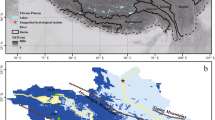Abstract
The change trends of air temperature, precipitation and evaporation from 1999 to 2008 shows that the climate in the Qinghai-Tibet Plateau permafrost region had become warmer. The analysis of the systematic active-layer data monitoring network along the Qinghai-Tibet Highway indicated that the active-layer thickness had been increasing and the soil temperature was rising. The soil temperature was rising in winter but not at the end of spring or during the entire summer. With thickening and warming of the active layer, the liquid water content of the active layer had an obvious downward migration and liquid water content in the top horizons decreased, but in the deeper horizons it increased.
Similar content being viewed by others
References
Anisimov OA, Shiklomanov NI, Nelson FE (1997) Global warming and active-layer thickness: results from transient general circulation models. Global and Planetary Change 15: 61–77.
Burn CR (1998) The Active Layer: Two contrasting definitions. Permafrost and Periglacial Process 9: 411–416.
Cheng GD (1983) The mechanism of repeated segregation for the formation of thick-layered ground ice. Cold Regions Science and Technology 8(1): 57–66.
Cheng GD, Wu TH (2007) Responses of permafrost to climate change and their environmental significance. Journal of Geophysical Research 112, F02S03, doi: 10.1029/2006JF000631.
Hinzman DH, Gieck RE (2008) Spacial and temporal variation of soil temperatures and arctic hydrology in the Kuparuk River basin Alaska. The Ninth International Conference of Permafrost, Fairbanks, University of Alaska. pp 711–716.
Hoekstra P (1996) Moisture movement in soils under temperature gradients with the cold-side temperature below freezing. Water Resources Research 2(2): 241–250.
Jin HJ, Zhao L, Wang SL, Jin R (2006) Thermal regimes and degradation modes of permafrost along the Qinghai-Tibet Highway. Science in China Series D: Earth Sciences 49(11): 1170–1183.
Kane DL, Hinkel KM, Goering DJ, et al. (2001) Non-conductive heat transfer associated with frozen soils. Global and Planetary Change 29: 275–292.
Kang SC, Xu Y, You Q, et al. (2010) Review of climate and cryospheric change in the Tibetan Plateau. Environment Research Letter 5, doi:10.1088/1748-9326/5/1/015101.
Osterkamp TE, Romanovsky VE (1997) Freezing of the active layer on the coastal plain of the Alaskan Arctic. Permafrost and Periglacial Process 8: 23–44.
Pang QQ, Zhao L, Li SX, et al. (2011) Active layer thickness variations on the Qinghai-Tibet Plateau under the scenarios of climate change. Environment Earth Science 66:849–857
Perfect E, Williams PJ (1980) Thermally induced water migration in frozen soils. Cold Regions Science and Technology 9(3): 101–109.
Roth K, Schulin R, Flühler H, et al. (1990) Calibration of time domain reflectometry for water content measurement using a composite dielectric approach. Water Resource Research 13: 909–914.
Tong CJ, Wu QB (1996) The effect of climate warming on the Qinghai-Tibet highway. Cold Regions Science and Technology 24: 101–106.
Wang GX, Hu HC, Li TB (2009) The influence of freeze-thaw cycles of active soil layer on surface runoff in a permafrost watershed. Journal of Hydrology 375: 438–449.
Wang SL, Yang MX (2000) Application of TDR to researching moisture variation in active layer on the Tibetan Plateau. Glaciology and Geocryology 20(1): 78–84.
Williams PJ, Smith MW (1989) The frozen earth: Fundamentals of Geocryology. Cambridge University Press, New York, pp 89–96.
Wu QB, Lu ZJ, Liu YZ (2005) Permafrost monitoring and its recent changes in Qinghai-Tibet Plateau. Advances in Climate Change Research 1(1): 26–28.
Wu QB, Zhang T (2008) Recent permafrost warming on the Qinghai-Tibetan Plateau. Journal of Geophysical Research 113, D13108, doi:10.1029/2007JD009539.
Wu QB, Zhang T (2010) Changes in active layer thickness over the Qinghai-Tibetan Plateau from 1995 to 2007. Journal of Geophysical Research 115, D09107, doi: 10.1029/2009JD012974.
Wu QB, Zhang T, Liu Y (2011) Thermal state of the active layer and permafrost along the Qinghai-Xizang (Tibet) railway from 2006 to 2010. The Cryosphere 5: 2465–2481.
Xu XZ, Wang JC, Zhang LX (2001) Physics of Frozen Soil., Science Press of China, Beijing. pp 45–70.
Yang MX, Nelson FE, Shiklomanov NI, et al. (2010) Permafrost degradation and its environmental effects on the Tibetan Plateau: A review of recent research. Earth-Science Reviews 103:31–44.
Zhang ZH, Kang ES, Jin BW, et al.(2003) A brief introduction to application of the TRIM E—TDR technology in the field experiment of the Hei River Basin. Journal of Glaciology and Geocrylogy 25(5): 574–579. (In Chinese with English abstract)
Zhao L, Wu QB, Marchenko SS, et al. (2010) Thermal state of permafrost and active layer in Central Asia during the International Polar Year. Permafrost and Periglacial Process 21: 198–207.
Zhao L, Cheng GD, Li SX (2003) Changes of plateau frozenground and environmental engineering effects. In: Zheng D. et al. (eds.), The Formation Environment and Development of Qinghai-Tibet Plateau. Heibei Science and Technology Press, Shijiazhang. pp. 143–150 (In Chinese).
Zhao L, Ping CL, Yang DQ, et al. (2004) Changes of climate and seasonally frozen ground over the past 30 years in Qinghai-Xizang (Tibetan) Plateau, China. Global Planet Change 43: 19–31.
Author information
Authors and Affiliations
Corresponding author
Rights and permissions
About this article
Cite this article
Xie, C., Zhao, L., Wu, T. et al. Changes in the thermal and hydraulic regime within the active layer in the Qinghai-Tibet Plateau. J. Mt. Sci. 9, 483–491 (2012). https://doi.org/10.1007/s11629-012-2352-3
Received:
Accepted:
Published:
Issue Date:
DOI: https://doi.org/10.1007/s11629-012-2352-3



